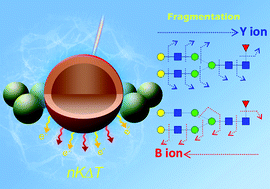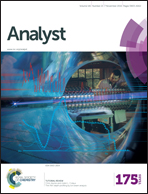Functionalized HgTe nanoparticles promote laser-induced solid phase ionization/dissociation for comprehensive glycan sequencing†
Abstract
Glycoconjugates are ubiquitously present and play a critical role in various biological processes. Due to their low stability and incredibly high degree of structural diversity, the structural characterization of glycan generally requires chemical derivatization and sophisticated instrumentation. Herein, we report a method for complicated glycan characterization in a single assay by employing 2,5-dihydroxybenzoic acid functionalized mercury telluride nanoparticles (HgTe@DHB NPs) as a dual ionization–dissociation element in matrix-assisted laser desorption/ionization mass spectrometry. Using a linear glycan, HgTe@DHB NPs promote laser-induced extensive and intense dissociation of the glycan, superior to HgTe microparticles and other inorganic nanoparticles (TiO2, ZnO, and Mn2O3 NPs). Abundant generation of diagnostic glycosidic (Y-, and B-type ions) and cross-ring cleavage (A-type ions) ions permits unambiguous determination of the composition, sequence, branching, and linkage of labile sialylated glycans. The general utility of this approach was demonstrated by the characterization of labile sialylated glycans and two sets of complicated isomeric glycans. This phenomenon was delineated further by investigating the NP's physico-chemical characteristics, revealing that their nanoscale-dependent thermodynamic properties, including UV absorption, photoelectron release dynamics and thermal energy, were the key to levitate temperature synergistically, thus inducing spontaneous glycan decomposition during the nanoparticle-assisted laser desorption–ionization process. Our results show that this “pseudo-MS/MS” obtained by HgTe@DHB can be beneficial for the analysis of biologically relevant and more complicated carbohydrates, without the need for chemical pre-derivatization and conventional tandem mass spectrometry.



 Please wait while we load your content...
Please wait while we load your content...